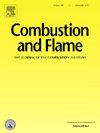Elucidating high-pressure chemistry in acetylene oxidation: Jet-stirred reactor experiments, pressure effects, and kinetic interpretation
IF 5.8
2区 工程技术
Q2 ENERGY & FUELS
引用次数: 0
Abstract
Acetylene plays a crucial role as an intermediate in the combustion of complex hydrocarbons, such as, e.g., jet fuels. In this study, high-pressure acetylene oxidation has been investigated by a combination of kinetic and experimental methods using a jet-stirred reactor (JSR) in the range of 497–910 K at p = 24 atm. The study covered three fuel-equivalence ratios: φ = 0.5 (fuel-lean), φ = 1.0 (stoichiometric), and φ = 3.0 (fuel-rich). Mole fraction profiles of 10 species, including CO, CO2, CH4, C2H4, C2H6, C3H6, C3H8, CH3OH, CH3CHO, and C3H4O, were identified and quantified using gas chromatography (GC) and gas chromatography-mass spectrometry (GC–MS). A kinetic model for describing the high-pressure chemistry of acetylene oxidation is proposed, which well characterizes important experimental findings, such as the fuel oxidation reactivity and the speciation of crucial products. At high pressures (p = 24 atm), acetylene exhibits a higher fuel consumption than at lower pressures (p = 1 and 12 atm) because of the increased sensitivity of dehydrogenation reactions by OH radicals accelerating the oxidation of the fuel at low temperatures. Furthermore, fuel-specific intermediates are observed, including acetaldehyde, propanal, small alkanes, and alkenes. These species mainly result from H-abstraction reactions by OH following O2-addition reactions from triple carbon bond moieties in acetylene. The formation of further products, such as carbon monoxide and carbon dioxide, is closely related to the consumption of these fuel-specific species. In particular, the formation of aromatics, such as e.g., benzene and toluene, are detected at trace levels in the current experiments due to the rapid formation and decomposition process occurring at high pressures. By analyzing the distinct kinetic behavior, it was found that acetylene was almost completely depleted at higher system pressure (p = 24 atm). Some intermediates are rather active and can react with O2 and peroxides. Consequently, the high-pressure oxidation of acetylene mainly proceeds along the pathway of C![]() C → CHCHOH → HOCHO/OCHCHO → CO → CO2 at the high-pressure chemistry (p = 24 atm). Overall, this study provides valuable insights into the pressure-dependent combustion behavior of acetylene and its implications for optimizing jet fuel combustion processes.
C → CHCHOH → HOCHO/OCHCHO → CO → CO2 at the high-pressure chemistry (p = 24 atm). Overall, this study provides valuable insights into the pressure-dependent combustion behavior of acetylene and its implications for optimizing jet fuel combustion processes.
阐明乙炔氧化过程中的高压化学反应:喷射搅拌反应器实验、压力效应和动力学解释
乙炔在复杂碳氢化合物(如喷气燃料)的燃烧过程中作为中间体起着至关重要的作用。本研究结合动力学和实验方法,使用喷射搅拌反应器(JSR)在 497-910 K、p = 24 atm 的条件下对高压乙炔氧化进行了研究。研究涵盖了三种燃料当量比:φ = 0.5(燃料贫乏)、φ = 1.0(化学计量)和φ = 3.0(燃料丰富)。利用气相色谱法(GC)和气相色谱-质谱法(GC-MS)对 CO、CO2、CH4、C2H4、C2H6、C3H6、C3H8、CH3OH、CH3CHO 和 C3H4O 等 10 种物质的分子分数剖面进行了鉴定和定量。提出了一个描述乙炔氧化高压化学反应的动力学模型,该模型很好地描述了重要的实验发现,如燃料氧化反应性和关键产物的种类。在高压(p = 24 atm)下,乙炔的燃料消耗量高于低压(p = 1 和 12 atm)下的燃料消耗量,这是因为在低温下,加速燃料氧化的 OH 自由基提高了脱氢反应的敏感性。此外,还观察到燃料特有的中间产物,包括乙醛、丙醛、小烷烃和烯烃。这些物质主要是乙炔中的三碳键分子发生 O2-加成反应后,OH 发生 H-萃取反应产生的。一氧化碳和二氧化碳等其他产物的形成与这些燃料特有物质的消耗密切相关。特别是,在目前的实验中,由于在高压下发生的快速形成和分解过程,在痕量水平上检测到了芳烃的形成,如苯和甲苯。通过分析不同的动力学行为,发现乙炔在较高的系统压力(p = 24 atm)下几乎完全耗尽。一些中间产物相当活跃,可以与氧气和过氧化物发生反应。因此,在高压化学反应(p = 24 atm)中,乙炔的高压氧化主要沿着 CC → CHCHOH → HOCHO/OCHCHO → CO → CO2 的路径进行。总之,这项研究为了解乙炔随压力变化的燃烧行为及其对优化喷气燃料燃烧过程的影响提供了宝贵的见解。
本文章由计算机程序翻译,如有差异,请以英文原文为准。
求助全文
约1分钟内获得全文
求助全文
来源期刊

Combustion and Flame
工程技术-工程:化工
CiteScore
9.50
自引率
20.50%
发文量
631
审稿时长
3.8 months
期刊介绍:
The mission of the journal is to publish high quality work from experimental, theoretical, and computational investigations on the fundamentals of combustion phenomena and closely allied matters. While submissions in all pertinent areas are welcomed, past and recent focus of the journal has been on:
Development and validation of reaction kinetics, reduction of reaction mechanisms and modeling of combustion systems, including:
Conventional, alternative and surrogate fuels;
Pollutants;
Particulate and aerosol formation and abatement;
Heterogeneous processes.
Experimental, theoretical, and computational studies of laminar and turbulent combustion phenomena, including:
Premixed and non-premixed flames;
Ignition and extinction phenomena;
Flame propagation;
Flame structure;
Instabilities and swirl;
Flame spread;
Multi-phase reactants.
Advances in diagnostic and computational methods in combustion, including:
Measurement and simulation of scalar and vector properties;
Novel techniques;
State-of-the art applications.
Fundamental investigations of combustion technologies and systems, including:
Internal combustion engines;
Gas turbines;
Small- and large-scale stationary combustion and power generation;
Catalytic combustion;
Combustion synthesis;
Combustion under extreme conditions;
New concepts.
 求助内容:
求助内容: 应助结果提醒方式:
应助结果提醒方式:


